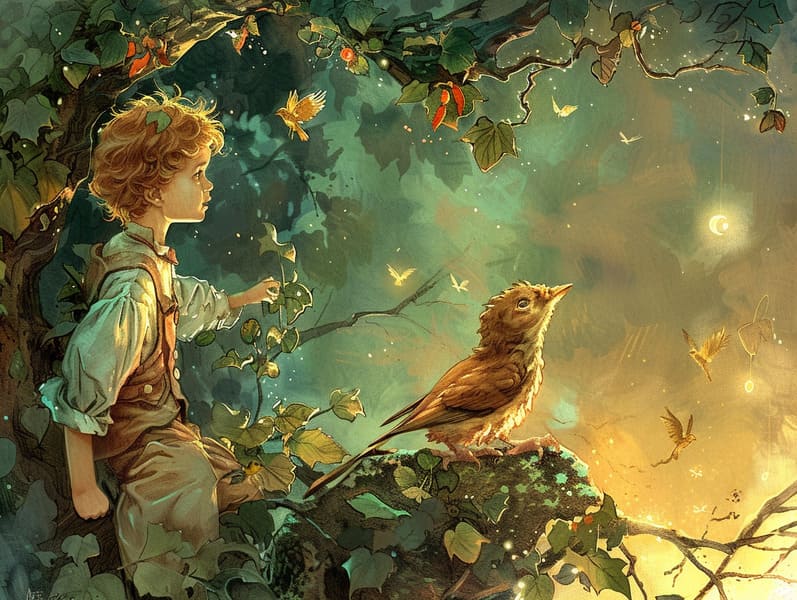The Evolution of Short Fairy Tales with the Ageless Appeal.
The Evolution of Short Fairy Tales with the Ageless Appeal.
Blog Article

Children's fairy tales have long histories. These stories have been spoken from one generation to the next centuries before they were ever inscribed. They were born from a variety of civilizations, including Indigenous traditions. They were initially disseminated among grown-ups, often carrying themes and messages aligned with the societal norms and beliefs of the time.
Jacob and Wilhelm Grimm, Jacob and Wilhelm Grimm, were among the first to gather and publish many of these beloved fairy tales. Their collection, "Grimm's Fairy Tales," included stories like "The Little Glass Slipper," "Hansel and Gretel," and "Little Snow White," which have since become mainstays in the world of timeless fairy tales. Similarly, Hans Andersen's delightful stories, such as "The Little Mermaid," and "The Ugly Duckling," have enchanted hearts worldwide, securing their place in the pantheon of classic fairy tales.
Despite their historical roots, these stories remain as impactful as ever, especially as children's night stories. These magical stories are now available in different formats, including artistically illustrated books, whimsical animations, and digital storybooks.
Their unwavering allure can be linked to several magical reasons:
Life Lessons: Classic fairy tales often offer important moral lessons. Fairy tales like "The Tale of the Boy Who Cried Wolf" teach the virtue of truth, while "The Hare and the Tortoise" exemplify the qualities of steadfastness and unassuming nature. These stories offer young ones clear distinctions between right and wrong, shaping their moral compass in a gentle yet deep way.
Warmth and Understanding: Classic fairy tales frequently portray beings facing challenges and struggles, provoking kids to sympathize with their struggles and rally behind their triumphs. For instance, "The Story of Beauty and the Beast" teaches us the merit of looking deeper to appreciate the true being of a soul, building insight and knowledge.
Cultural Comprehension: Many traditional fairy tales are infused with the cultural contexts from which they grew. Immersing in these fairy tales can provide intriguing perspectives into different heritages, promoting a sense of world appreciation and appreciation.
Fantasy and Imagination: The extraordinary elements in timeless fairy tales—talking beasts—engender children’s fantastical thinking. These stories lead readers to fantasy realms, provoking inventive thinking and a sense of astonishment that remains a lifetime.
Traditional fairy tales are not only alluring but also teaching. They function as delightful tools in strengthening various cognitive and affective skills in kids. When timeless fairy tales are recited, they improve verbal skills by bringing new vocabulary and detailed sentence structures. This practice also advances click here hearing abilities and attention span, as the young keep up with the story, enthusiastic to see what happens next.
Furthermore, analyzing the themes and characters of timeless fairy tales can promote intellectual skills and intellectual skills. Young ones are taught to identify patterns, make predictions, and get cause and effect. These explorations also boost the young communicate their thoughts and feelings, contributing to their emotional intelligence.
In today’s technological era, the existence of free fairy tales online has made these stories more obtainable than ever. Web platforms and applications extend large libraries of ancient fairy tales that can be enjoyed or listened on anytime, anywhere. Fairy tales told out loud are particularly liked, presenting an fascinating method for little ones to savor these charming tales. Read-aloud stories and read-aloud videos bring characters and settings to life, often supported by whimsical sound effects and background music that enrich the narrative journey.
The everlasting appeal of timeless fairy tales lies in their ability to adapt to contemporary times while preserving their central messages. Contemporary adaptations of these fairy tales often integrate more representative protagonists and modern settings, making them accessible to today’s audience. However, the central morals of gallantry, sympathy, and fair-mindedness remain unchanged, continuing to appeal to children of all ages.
Traditional fairy tales also offer a sense of protection and homeliness. They highlight a organized narrative with a straightforward beginning, middle, and end, often wrapping up with the culmination of conflicts and the triumph of honesty over deceit. This reliability can be relieving for little ones, distributing a sense of assuredness in an inconstant world.
Timeless fairy tales continue to captivate and instruct new generations, maintaining their captivation and meaningfulness in modern society. As children's night stories, they share a perfect blend of charm and understanding, developing moral values, empathy, and creativity. The prevalence of online storybooks and the well-received status of fairy tales voiced ensure that these traditional narratives remain accessible to new generations.
By sustaining and imparting these stories, we continue to recognize the rich tapestry of tales and cultural heritage. Whether you are reading a richly illustrated book, delving into a online collection, or listening on an audiobook, the loveliness of bedtime fairy tales is always within reach. These narratives convey of the persistent spell of fairy tales and its ability to hold us together across eras and regions.
If you are experiencing a colorful picture book, accessing a virtual library, or listening on an spoken story, the wonder of famous fairy tales is always within reach.
These fairy tales point out of the unchanging effect of tales and its ability to tie us across eras and regions, weaving a spell that delights and instructs alike.